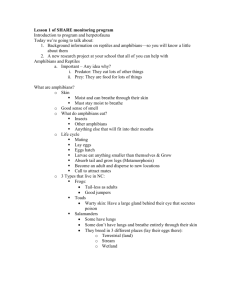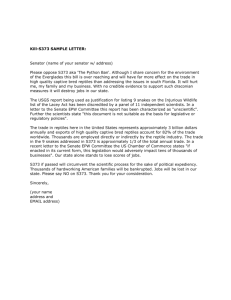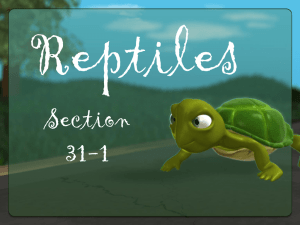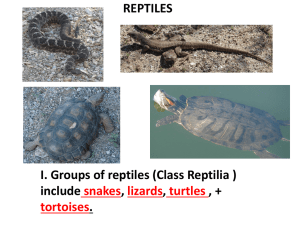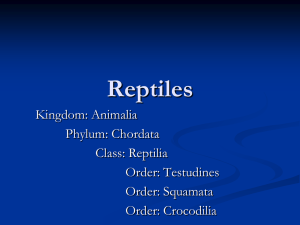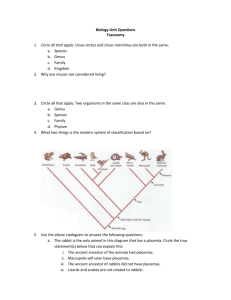A. Anapsid Reptiles
advertisement
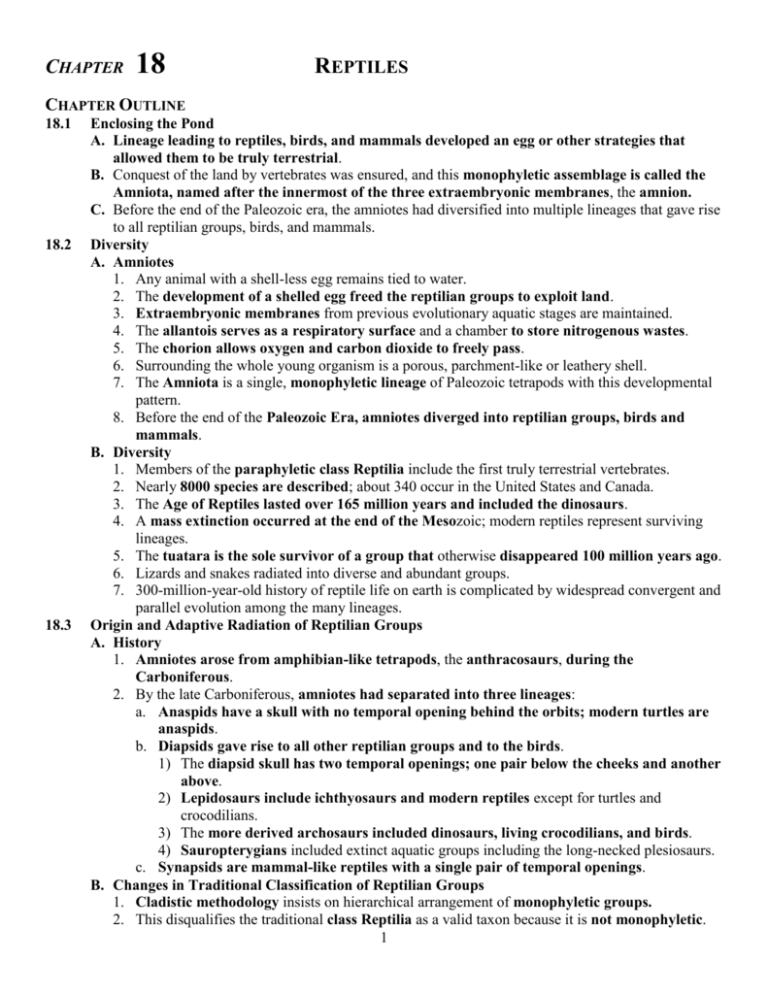
CHAPTER 18 REPTILES CHAPTER OUTLINE 18.1 18.2 18.3 Enclosing the Pond A. Lineage leading to reptiles, birds, and mammals developed an egg or other strategies that allowed them to be truly terrestrial. B. Conquest of the land by vertebrates was ensured, and this monophyletic assemblage is called the Amniota, named after the innermost of the three extraembryonic membranes, the amnion. C. Before the end of the Paleozoic era, the amniotes had diversified into multiple lineages that gave rise to all reptilian groups, birds, and mammals. Diversity A. Amniotes 1. Any animal with a shell-less egg remains tied to water. 2. The development of a shelled egg freed the reptilian groups to exploit land. 3. Extraembryonic membranes from previous evolutionary aquatic stages are maintained. 4. The allantois serves as a respiratory surface and a chamber to store nitrogenous wastes. 5. The chorion allows oxygen and carbon dioxide to freely pass. 6. Surrounding the whole young organism is a porous, parchment-like or leathery shell. 7. The Amniota is a single, monophyletic lineage of Paleozoic tetrapods with this developmental pattern. 8. Before the end of the Paleozoic Era, amniotes diverged into reptilian groups, birds and mammals. B. Diversity 1. Members of the paraphyletic class Reptilia include the first truly terrestrial vertebrates. 2. Nearly 8000 species are described; about 340 occur in the United States and Canada. 3. The Age of Reptiles lasted over 165 million years and included the dinosaurs. 4. A mass extinction occurred at the end of the Mesozoic; modern reptiles represent surviving lineages. 5. The tuatara is the sole survivor of a group that otherwise disappeared 100 million years ago. 6. Lizards and snakes radiated into diverse and abundant groups. 7. 300-million-year-old history of reptile life on earth is complicated by widespread convergent and parallel evolution among the many lineages. Origin and Adaptive Radiation of Reptilian Groups A. History 1. Amniotes arose from amphibian-like tetrapods, the anthracosaurs, during the Carboniferous. 2. By the late Carboniferous, amniotes had separated into three lineages: a. Anaspids have a skull with no temporal opening behind the orbits; modern turtles are anaspids. b. Diapsids gave rise to all other reptilian groups and to the birds. 1) The diapsid skull has two temporal openings; one pair below the cheeks and another above. 2) Lepidosaurs include ichthyosaurs and modern reptiles except for turtles and crocodilians. 3) The more derived archosaurs included dinosaurs, living crocodilians, and birds. 4) Sauropterygians included extinct aquatic groups including the long-necked plesiosaurs. c. Synapsids are mammal-like reptiles with a single pair of temporal openings. B. Changes in Traditional Classification of Reptilian Groups 1. Cladistic methodology insists on hierarchical arrangement of monophyletic groups. 2. This disqualifies the traditional class Reptilia as a valid taxon because it is not monophyletic. 1 18.4 3. Class Reptilia excludes birds, which descend from the most recent common ancestor of reptiles. 4. This makes the class Reptilia a paraphyletic group because it does not include all descendants and their most recent common ancestor. 5. Reptiles are therefore identified as amniotes that are not birds. 6. Based solely on shared derived characteristics, crocodilians and birds are sister groups belonging to a monophyletic group apart from other reptiles, the Archosauria. 7. Some taxonomists defined Reptilia as the Archosauria plus the lepidosaurs, thus including birds. 8. Evolutionary taxonomists argue that birds represent a novel adaptive zone and grade of organization; they maintain the class Aves based on the morphological and ecological novelty of birds. 9. “Reptilian group” refers to members of four monophyletic groups formerly considered class Reptilia. Characteristics Distinguishing Reptiles from Amphibians A. Skin 1. Reptiles have a tough, dry, scaly skin that offers protection against desiccation and injury. 2. The thin epidermis is shed periodically. 3. A thicker, well-developed dermis underneath has chromatophores that provide color. 4. The dermis is converted to snakeskin leather for shoes and pocketbooks. 5. Reptile scales are primarily of keratin, formed from epidermis, and not homologous with fish scales. 6. Scales may grow gradually to replace wear, as in alligators. 7. Snakes and lizards replace old scales with new and “shed their skins.” 8. Turtles add new layers underneath old layers of platelike scutes. B. Shelled Egg 1. A shelled egg contains food and protective membranes to support embryonic development on land. 2. The chorion and allantois exchange carbon dioxide and oxygen with the environment. 3. The amnion and shell support the growing embryo and reduce water loss. 4. The shelled egg widened the division between evolving amphibians and reptiles. C. Reptilian Jaws 1. The jaws of fish allowed fast jaw closure to seize food but little force for chewing. 2. In reptiles, jaw muscles became larger and arranged for the mechanics of chewing. D. Internal Fertilization 1. A shelled egg requires internal fertilization; the sperm must reach the egg before it is enclosed. 2. Reptiles have some form of copulatory organ, permitting internal fertilization. 3. Paired testes produce sperm that are carried by vasa deferentia to the copulatory organ. 4. The female has paired ovaries and oviducts. 5. Glandular walls of the oviducts secrete albumin and shells for the relatively large eggs. E. Circulatory System Modifications 1. Reptiles have an efficient circulatory system and higher blood pressure than amphibians. 2. The right atrium that receives unoxygenated blood is completely partitioned from the left atrium. 3. Crocodilians have separated ventricles dividing pulmonary and systemic circulation. 4. Other reptiles have an incompletely separated ventricle but little mixture of blood occurs and the effect is two functionally separate circulations. 5. Incomplete separation between heart sides permits blood to bypass the lungs during diving or aestivation. F. Lungs 1. Reptile lungs are better developed than those of amphibians. 2 2. Reptiles depend almost exclusively on lungs for respiration, supplemented by pharyngeal membranes. 3. Inspiration occurs by enlarging the thoracic cavity; some aquatic species use the pharynx, cloaca, and skin. 4. Snakes and lizards use expansion of the rib cage; turtles and crocodilians use movement of internal organs to create negative pressure to inhale (i.e., reptiles “suck” air into the lungs, unlike amphibians, which “force” air into the lungs) 5. Reptiles lack diaphragms. G. Water Conservation 1. All amniotes have a metanephric kidney drained by the ureter. 2. Nephrons of the reptilian metanephros lack the loop of Henle that allows concentration of solutes. 3. Many reptiles have salt glands near the nose or eyes to secrete salty fluid hyperosmotic to body fluids. 4. Nitrogenous wastes are excreted as uric acid rather than urea or ammonia. 5. Uric acid has low solubility and precipitates readily; this allows water to be conserved. H. Support of Limbs for Locomotion 1. Except for limbless members, all reptiles have better body support than amphibians. 2. Many modern reptiles still walk with legs splayed outward and the belly close to the ground. 3. Most dinosaurs and some modern lizards have more efficient legs directed beneath the body. 4. Bipedal locomotion is superior to quadrupedal locomotion if speed and better support of the body is required. I. Nervous System 1. The reptilian nervous system is considerably more complex than the amphibian. 2. The reptile brain is still small but the cerebrum is relatively larger. 3. Sense organs are generally well developed, except for hearing. 4. The Jacobson’s organ is highly developed in lizards and snakes to detect odors carried by the tongue. 18.5 Characteristics and Natural History of Reptilian Orders A. Anapsid Reptiles: Subclass Anapsida 1. Order Testudines (Chelonia) includes the turtles. 2. Turtles descended from one of the earliest anapsid lineages, probably in the late Permian. 3. Fossils appear in the Upper Triassic, 200 million years ago, and they have occurred ever since. 4. The shells consist of the dorsal carapace and the ventral plastron. 5. The bony layer is a fusion of ribs, vertebrae, and dermally-ossified elements – the shell. 6. The shell offers protection for the head and appendages. 7. Turtles lack teeth and have tough, horny plates for gripping food. 8. Breathing a. One consequence of having a rigid shell is the turtle cannot expand its chest to breathe. b. Turtles solve this problem by using abdominal and pectoral muscles as a “diaphragm.” c. Air is drawn in by contraction of the limb flank muscles, increasing abdominal cavity volume. d. Exhalation is accomplished by drawing back the shoulder girdle to compress the viscera. 9. Nervous System and Senses a. Turtles have a middle and an inner ear but sound perception is poor; they make few sounds aside from during mating. b. Turtles have a good sense of smell, acute vision, and color perception about equal to humans. 10. Reproduction and Development a. Turtles are oviparous; fertilization is internal and all turtles bury their eggs in the ground. 3 b. In some turtle families, as in crocodilians and some lizards, nest temperature determines the sex of hatchlings; low temperatures produce males and high temperatures produce females. 11. Giant Turtles a. Buoyed by the water, marine turtles may reach two meters long and 725 kilograms in weight. b. Giant land tortoises, such as those on the Galápagos Islands, weigh several hundred kilograms. c. Low metabolic activity may explain their longevity believed to exceed 150 years. B. Diapsid Reptiles: Subclass Diapsida (skull with two pairs of temporal openings) 1. Consists of superorders: a. Lepidosauria – lizards, snakes, worm lizards, and Sphenodon. b. Archosauria – crocodilians (and birds in classic taxonomy). 2. Order Squamata: 3 lineages: Lizards, Snakes and Worm Lizards a. Squamates are the most recent and diverse of diapsids; they make up 95% of living reptiles. b. Lizards appeared in the fossil record in the Permian but did not radiate until the Cretaceous. c. Snakes appeared in the Jurassic from a group whose descendants include monitor lizards. d. Snakes gained specializations for losing their legs and therefore for engulfing large prey. e. Amphisbaenians probably evolved from lizards and are specialized for burrowing. f. Diapsid skulls have lost dermal bone ventral and posterior to the lower temporal opening. 1) This permitted evolution in lizards of a mobile skull with movable joints, a kinetic skull. 2) The quadrate, fused to the skull in other reptiles, has a joint at the dorsal end and articulates with the lower jaw. 3) Joints in the palate and across the roof of the skull permit the snout to be tilted up. 4) Squamates seize and manipulate prey; they close the jaw with force. 5) Exceptional skull mobility of snakes is considered a major factor in their diversification. g. Viviparity 1) Viviparity in reptiles is limited to squamates. 2) It has evolved at least 100 separate times. 3) It is associated with cold climates. 4) Viviparity involves increasing the length of time eggs are kept in the oviduct. 5) Developing young respire through extraembryonic membranes. 6) Young obtain nutrition from yolk sacs or via the mother, or a combination of both. 3. Lizards: Suborder Sauria a. Lizards are a diverse group with terrestrial, burrowing, aquatic, arboreal, and some aerial members. 1) Geckos are small, agile, nocturnal forms; adhesive toe pads with extremely fine filaments that allow them to walk on ceilings. 2) Iguanids include many New World lizards as well as the marine iguana of the Galápagos. 3) Chameleons are lizards of Africa and Madagascar; many have an extendible tongue. 4) Skinks have elongate bodies and reduced limbs. 5) Some lizards have degenerate limbs; the glass lizards are nearly limbless. b. Lizards have movable eyelids whereas snakes have a transparent covering. c. Nocturnal geckos have retinas with only rods; day-active lizards have both rods and cones. d. Lizards have an external ear that snakes lack. 4 e. Geckos use vocal signals to announce territory and drive away males. f. Some lizards survive well in hot and dry regions. 1) They conserve water by producing crystalline uric acid. 2) Water loss is also minimized with lipids in thick skin. 3) Some lizards store fat in their tails to provide energy and metabolic water during drought. g. The Gila monster and beaded lizard are the only lizards capable of a venomous bite. h. Lizards are ectothermic, few live in cold climates. 1) Ectotherms use less energy than endotherms; they survive in habitats with low productivity and warm climates such as tropical deserts and grasslands. 2) Ectotherm is not an inferior characteristic but a successful environmental coping strategy. 3) Lizards keep their body temperature relatively constant by behavioral thermoregulation. 4. Worm Lizards: Suborder Amphisbaenia a. These are highly specialized burrowing forms that are not true lizards. b. They generally lack any trace of external limbs; eyes and ears are hidden under the skin. c. The skin is divided into numerous rings resembling earthworms. d. One species occurs in Florida but most live in South America and tropical Africa. 5. The Mesozoic World of Dinosaurs a. History 1) Richard Owen coined term “dinosaur”—terrible lizard—in 1841. 2) Two basic groups: “lizard-hipped” Saurischia and “bird-hipped” Ornithischia 3) Dinosaurs and their living relatives, the birds, are archosaurs, which includes thecodonts, crocodilians, and pterosaurs. 4) Walking upright is well illustrated in genus Herrerasaurus, from Argentina. b. Saurischian Diversity: 1) Two groups of saurischian dinosaurs existed based on difference in feeding habits and locomotion: the carnivorous and bipedal theropods, and the herbivorous and quadrupedal sauropods. 2) Some small sauropods reached 25 m (82 feet in length), but Argentinosaurus was adapted to feed on trees and reached sizes of 40 meters (132 ft). 3) Coelophysis was a typical theropod with powerful hind legs, slender grasping forelimbs, a flexible neck, long counterbalancing tail, and large head with jaws and daggerlike teeth. c. Ornithischian Diversity 1) Quite varied, they were all herbivores. 2) Many diverse forms are united by several derived skeletal features indicating common ancestry (e.g., Triceratops). 3) The huge back-plated Stegosaurus of the Jurassic is an armored ornithischian. 4) Hadrosaurs probably communicated with elaborate skull crests used as vocal resonators. d. Parental Care 1) Recent fossil discoveries reveal dinosaurs exhibited complex parental care. 2) An adult theropod Oviraptor was found probably with its own eggs. 3) Wear on teeth of baby hadrosurs suggest they were fed by parents in the nest. e. Extinction 1) Dinosaurs became extinct 65 million years ago leaving crocodiles and birds as survivors. 2) A large asteroid impact or changing climate and landforms may have caused their demise. 3) Paleontologists are still puzzled by dinosaur extinction yet persistence of other vertebrates. 6. Snakes: Suborder Serpentes 5 a. Snakes are limbless and have lost the pectoral and pelvic girdles (except for vestigial structures in pythons). 1) The many vertebrae are shorter and wider than in other tetrapods, allowing undulation. 2) Ribs increase vertebral column rigidity thereby improving resistance to lateral stresses. 3) Elevation of the neural spine gives the musculature more leverage. b. Their feeding apparatus allows them to eat prey several times their own diameter. 1) The two halves of the lower jaw are loosely joined, allowing them to spread apart. 2) The skull bones also are loosely articulated so the mouth can accommodate large prey. c. Eyeballs have reduced mobility and a permanent corneal membrane for protection. d. Most snakes have poor vision but arboreal snakes in tropical forests have highly developed vision. e. Snakes lack external ears but respond to low frequency vibrations and ground vibrations. f. Chemical senses rather than vision or hearing, are the main senses snakes use to hunt prey. g. Jacobson’s organs are a pair of pits in the roof of the mouth; they are lined with olfactory epithelium and the forked tongue picks up scent particles and conveys them past this organ. h Many snakes swallow their prey alive. 1) Smaller prey may cause less injury due to struggles. 2) Worms, insects, frogs, and small mammals are eaten. 3) Some snakes locate prey by actively foraging. 4) Constrictors often feed on larger mammals using ambush tactics. 5) Muscle arrangements in constrictors reduce their travel speeds. i. Venomous Snakes 1) Less than 20% of all snakes are venomous except in Australia. 2) Venomous snakes are divided into five families. 3) Family Viperidae includes New World and Old World vipers with and without pits. 4) Family Elapidae includes cobras, mambas, coral snakes, and kraits. 5) Family Hydrophiidae includes the highly venomous sea snakes. 6) Fossorial mole vipers are found in the family Atractaspididae. 7) Most members of the family Colubridae are non-venomous; several including the African boomslang and African twig snake are rear-fanged and their bite can be fatal to humans. k. Pit vipers, such as rattlesnakes, have “pits” with nerve endings sensitive to heat emitted by warm-bodied birds and mammals . 1). Viper fangs are hollow and hinged to inject venom when the snake strikes. 2) Of an average 8,000 snake bites each year in the U.S., only 5-10 deaths result from pit vipers. 3) A pair of modified teeth on the maxillary bones serves as fangs. 4) Fangs become erect during a strike; venom is injected through their canals. 5) Prey are paralyzed or die after the bite then swallowed whole by the viper. l. Snakebite and Toxicity 1) Saliva of harmless snakes contains limited toxins; this provided a basis for natural selection of venom. 2) Most snake venoms are a complex combination of venom types. 3) Neurotoxins act on the nervous system, causing blindness or stopping respiration. 4) Hemorrhagin type venoms breaks down blood vessels and red blood cells; much blood is leaked into tissue spaces. 5) Sea snakes and the Australian tiger snake have the most deadly venom per unit. 6 6) Large venomous snakes deliver more venom; a king cobra may be the most dangerous. 7) In India, Pakistan, and other nearby countries, dense human populations with poor footwear and delayed medical care contributes to most deaths from snakebites. 8) Worldwide, approximately 50,000-60,000 persons die each year from snakebites. m. Reproduction 1) Most snakes are oviparous and lay shelled eggs under logs or rocks or in holes in the ground. 2) Others, including pit vipers, are ovoviviparous (the egg hatches internally to facilitate a live birth). 3) A few snakes are viviparous, having a primitive “placenta” to exchange nutrients with the young. 7. Order Sphenodonta: The Tuatara a. Only two living species in New Zealand represent this ancient lineage . b. Sphenodontids radiated modestly in the early Mesozoic but then declined. c. Once widespread across New Zealand, the two species are now restricted to small islands. d. They are lizard-like and live in burrows often shared with petrels. e. The tuatara is slow growing and may live to 77 years of age. f. Its skull is nearly identical to diapsid skulls of 200 million years ago. g. A well-developed median parietal eye is buried beneath its skin, function is unknown. h. Sphenodon represents one of the slowest rates of evolution known among vertebrates. 8. Order Crocodilia: Crocodiles and Alligators a. Modern crocodilians are the only surviving reptiles of the archosaurian lineage. b. This lineage gave rise to the Mesozoic radiation of dinosaurs and to birds. c. Modern crocodilians differ little from primitive crocodilians of the early Mesozoic. d. Modern crocodilians are classified in three families. 1) Alligators and caimans are found primarily in the New World; they have a broader snout. 2) Crocodiles are widely distributed and include the huge saltwater crocodile. 3) Gavials have one species in India and Burma; it has a very narrow snout. e. All have a long, well-reinforced skull and jaw musculature for a powerful bite. f. Teeth are set in sockets typical of archosaurs and the earliest birds. g. They have a complete secondary palate, a feature only shared with mammals. h. They also share a four-chambered heart with birds and mammals. i. The estuarine crocodile in southern Asia and the Nile crocodile are both very large. j. Crocodiles may attack cattle, deer, and people; alligators are less aggressive. k. Alligators and crocodiles are oviparous; usually 20-50 eggs are laid in a mass of vegetation. 1) Alligators emit loud bellows during the mating season. 2) Females of crocodiles and alligators guard their eggs then open nest sites when young hatch. 3) Nests left unguarded are easily discovered and raided by predators. 4) High nest temperatures produce males; low temperatures produce females. 7
